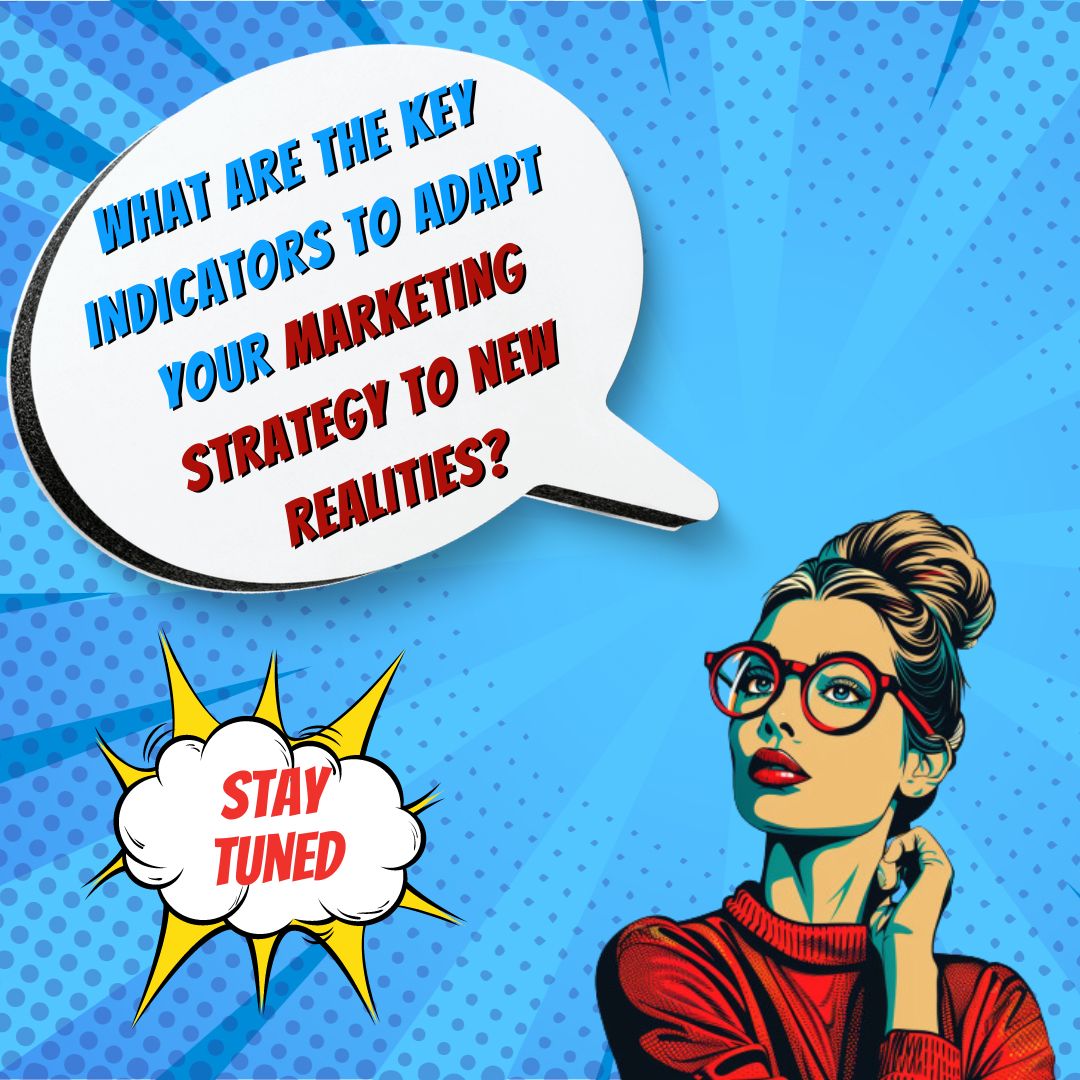Key Takeaways
✅ Stay Attuned to Market Dynamics: Understanding shifts in consumer behavior, technology, and global events is essential to pivot your marketing approach effectively. Nearly 60% of marketers update their strategies yearly due to market changes. Regular market research and data-driven insights can help adjust your strategy to remain relevant and efficient.
✅ Embrace Innovation and Agility: With the digital landscape evolving, agility and innovation become your strongest assets. Companies that integrate digital transformation and influencer marketing into their strategies see an average boost in engagement rates by up to 70%. Foster a culture of flexibility to swiftly adapt to market changes and opportunities.
✅ Prioritize Customer Experience and Consistency: Personalizing customer experience is no longer an option but a necessity, with 80% of consumers more likely to purchase from brands that offer personalized experiences. Consistency in your messaging across all platforms ensures trust and loyalty, bolstering your brand’s standing in the competitive market.

Introduction
Are you feeling overwhelmed by the relentless waves of marketing trends and technologies? If so, you're not alone. The significance of Adapting Your Marketing Strategy to a Changing Reality has never been more critical. Between the rapid advancement of digital tools and evolving customer expectations, businesses are finding themselves at a crossroads: innovate or fall behind.
This article is your guiding light in the murky waters of modern marketing. From the rise of digitalization and its transformative effects to understanding the ever-evolving landscape shaped by consumer behavior and technology — we cover it all. Embracing innovative marketing techniques such as influencer marketing, voice search optimization, and augmented reality, can leapfrog your strategies into new frontiers of engagement and sales.
The introduction of actionable insights and groundbreaking data analysis promises to not only tweak but revolutionize your marketing approach. Prepare to dive into an ocean of possibilities where adapting your marketing strategy could mean the difference between surviving and thriving in today’s competitive market. Stay tuned for a journey that will uncover modern trends, techniques, and solutions designed to maximize your revenue, return on ad spend (ROAS), and overall return on investment (ROI).

Top Statistics
| Statistic | Insight |
|---|---|
| Global Digital Ad Spending: Expected to reach $645 billion by 2024. | This staggering number not only shows the enduring power of digital platforms but also marks a significant shift where brands are investing more to catch consumers’ eyes online. |
| AI Usage in Marketing: Grown by 186% from 2018 to 2020. | AI is no longer just a buzzword but a critical tool that’s shaping personalized experiences, making it essential for businesses to explore AI capabilities. |
| Personalization: 78% of consumers are more likely to make a purchase from a brand that personalizes content. | Personalization goes beyond merely addressing the customer by name. Understanding individual customer behaviors and preferences can dramatically boost your conversion rates. |
| Marketing ROI Through Data: Companies using big data saw an 8% profit increase and a 10% reduction in overall cost. | Big data is not just for the big players anymore. Properly analyzing data can unveil insights that lead to more effective and efficient marketing strategies for businesses of all sizes. |
| Documented Strategy: Marketers with a documented strategy are 414% more likely to report success. | Having a documented strategy offers clarity and a sense of direction, ensuring every team member knows the goals and how to achieve them. |
Embracing Digital Transformation in Marketing
The digital age has truly changed how businesses talk to their customers. Gone are the days when traditional methods like flyers and billboards were the main ways to catch a consumer's eye. Now, it's all about digital channels like social media, SEO, and content marketing. These tools allow companies to throw a wider net, capturing the attention of a broader audience in a way that's both cost-effective and sharp in focus. Think about it. Wouldn't it be better to spend less and still talk directly to the people who are most interested in what you have to offer?

Keeping Up with the Marketing Times
With every new app or gadget, the landscape of marketing shifts a bit. It’s a world that’s always moving, shaped by the latest tech and what people want at any given moment. For businesses, staying in the know is not just good practice—it's survival. Why? Because understanding what your customers need and what bothers them is key to crafting messages and campaigns that hit home. And in a world where everyone’s bombarded with ads 24/7, being relevant is the name of the game.
The Power of Data in Making Decisions
In today’s marketing world, data is like gold. It tells you what’s working, what’s not, and more importantly, why. By diving deep into consumer data, businesses can tailor their efforts in a way that feels less like shooting in the dark and more like a precision strike. Tools such as Google Analytics and CRM software are the lenses through which companies can see their customers more clearly, adjusting their sails as they navigate the vast sea of market preferences and behaviors.
Making It Personal: The Customer Experience
Now, more than ever, personalization is what sets companies apart in the hearts and minds of customers. People don’t just buy products; they buy experiences, stories, and connections. By crafting marketing messages for specific segments of your audience, you not only boost engagement but also pave the way for better conversion rates. And let’s not forget the importance of a seamless journey across all touchpoints—from Instagram ads to customer service calls—ensuring every interaction adds another brick to the foundation of loyalty and advocacy.
Stepping into the Future with Innovative Techniques
To truly stand out, dipping your toes into emerging trends and technologies might just be the push your marketing needs. Take influencer marketing, for example. It's not just about celebrity endorsements anymore but about finding voices that resonate deeply with your brand's values and your audience's interests. Then there's voice search optimization, which makes your content more accessible and aligns with the natural way people talk and ask questions. And let’s not overlook augmented reality's magic in letting customers 'try' products from the comfort of their homes, enhancing confidence and driving sales in ways traditional photos simply cannot.

Measuring Success: The Importance of KPIs
At the end of the day, how do you know if all these efforts are paying off? Measuring performance through KPIs like click-through rates, conversion rates, and ROI is vital. These metrics offer a clear view of what strategies are working and which ones need a tweak or two. By analyzing these outcomes, companies can not only celebrate victories but also learn from missteps, ensuring that each campaign is one step closer to marketing mastery.
In sum, as we navigate this ever-changing digital landscape, the companies that thrive will be those that stay curious, adaptable, and always focused on the heart of marketing: connecting with people in meaningful ways.
AI Marketing Engineers Recommendation
Recommendation 1: Embrace Adapting Your Marketing Strategy to a Changing Reality through Data Analytics: Leveraging data analytics is more crucial than ever. With the surge in online interactions, there's a goldmine of data available that can inform your strategy. A recent report by Forbes highlighted that companies leveraging customer behavior data outperform peers by 85% in sales growth. By applying predictive analytics, businesses can forecast trends, understand customer behaviors, and adapt strategies in real time, ensuring they meet the market's changing demands effectively.
Recommendation 2: Invest in Agile Marketing Approaches: The concept of agility in marketing isn't new, but its importance has skyrocketed. The traditional long-term planning cycles are no longer as effective. Instead, adopting an agile marketing approach allows businesses to be more responsive. According to the State of Agile Marketing Report by AgileSherpas, 41% of marketers reported that adopting agile methodologies significantly improved their speed to market for ideas, campaigns, and products. This includes working in sprints, constant testing, and learning to quickly adapt to what's working and what isn't.
Recommendation 3: Prioritize Customer Experience Through Personalization: Personalizing the customer experience is becoming the cornerstone of successful marketing strategies. A survey conducted by Epsilon indicated that 80% of consumers are more likely to make a purchase when brands offer personalized experiences. Advanced tools and platforms now allow marketers to tailor content, recommendations, and interactions to the individual level at scale. This adaptation not only satisfies the modern consumer’s expectations but significantly boosts loyalty and conversion rates. Implementing technologies such as AI-powered recommendation engines can dynamically adjust content and recommendations on websites, emails, and social media platforms to match consumer behavior and preferences, making Adapting Your Marketing Strategy to a Changing Reality not just a necessity, but a formidable advantage.

Conclusion
In a world where digital transformation shapes every corner of our lives, adapting your marketing strategy is not just beneficial; it's essential. From the shift away from traditional marketing methods to the embrace of digital strategies, businesses are finding dynamic ways to reach wider audiences more effectively and economically. The importance of understanding the evolving marketing landscape has never been clearer. With consumer preferences and technology changing at lightning speed, staying informed and agile allows your business to remain competitive and relevant.
A key takeaway is the role of data-driven decision making in crafting successful marketing strategies. In today's market, data is gold. It empowers businesses to make informed decisions, understand consumer behavior better, and tailor their efforts for maximum impact. Furthermore, the move towards personalization and an unmatched customer experience highlights the need for companies to see their customers as unique individuals, each with their own needs and desires.
Yet, none of this would be possible without leveraging innovative techniques and measuring the outcomes of our efforts. From the exciting realms of influencer marketing and augmented reality to the precision of voice search optimization, innovation drives progress. Equally, the rigorous analysis of marketing outcomes ensures that progress leads to results. With measurable insights, businesses are better equipped to refine their strategies, ensuring that every step taken is one guided by knowledge and purpose.
As we look toward the future, let this exploration serve as both a reflection and a call to action. The landscape of marketing will continue to evolve, and with it, so must our strategies. Embracing change, educating ourselves on new trends, and putting data at the forefront of decision-making processes are steps we must take to thrive. Let's move forward with a commitment to adaptation, creativity, and continuous learning. The possibilities are limitless for those willing to adapt their marketing strategies to the ever-changing reality we face today.

FAQs
Question 1: Why is adapting a marketing strategy important?
Answer: Adapting a marketing strategy is all about keeping your business on its toes, ready to swing with the punches. It's crucial for staying in the game as consumer tastes, technology, and the market itself evolve. Imagine trying to win a race with your feet stuck in cement—that's what sticking to an old marketing plan feels like.
Question 2: What are the key components of a successful marketing strategy?
Answer: Think of a successful marketing strategy as a recipe. You need a dash of understanding your customer's cravings, a spoonful of standing out from the crowd, a cup of shouting your uniqueness from the rooftops, a pinch of building strong friendships with your customers, and a whole lot of tasting and tweaking your recipe until it's just right.
Question 3: What is the role of a marketing strategy in driving business growth?
Answer: A stellar marketing strategy is your treasure map to business growth. It helps you spot your audience from a mile away, dress your brand in armor to face its foes, unfurl your unique flag, and build a ship strong enough to sail through the toughest storms, all while keeping an eye on the treasure—growth and revenue.
Question 4: What is the difference between standardization and adaptation in marketing?
Answer: It's the classic tale of one size fits all versus tailoring to taste. Standardization throws the same net everywhere, hoping to catch something, while adaptation crafts different nets for different waters, aiming for the choicest fish by respecting the local flavors.
Question 5: How does diversity marketing fit into an adaptation strategy?
Answer: Diversity marketing is like a master chef who knows that the secret to a hearty meal lies in catering to the diverse tastes of their guests. It's all about tweaking your marketing recipe to respect and embrace the rich tapestry of cultures and demographics out there.
Question 6: What are the benefits of adapting marketing strategies mid-year?
Answer: Changing your game plan mid-year is like finding a shortcut when you're stuck in traffic. It helps you steer clear of dead ends (stagnating sales), catch a fresh wind (market changes), and sail smoothly towards your destination (goals).
Question 7: How do you determine when to pivot marketing strategies?
Answer: Knowing when to pivot is like sensing a change in the weather. If sales are not just asleep but in hibernation, or if the market landscape has shifted, it's time to chart a new course. Regular check-ups can help you spot these signals before you're off course.
Question 8: What questions should you ask when adapting your marketing strategy?
Answer: When thinking of a pivot, you might ask yourself: What makes us stand out in a crowd? Who are our most enthusiastic fans (best customers)? What's our competition up to, and how's the market feeling right now? It's like gathering intel for a strategic move.
Question 9: How do you measure the success of an adapted marketing strategy?
Answer: Success is in the eye of the beholder—or in this case, in the numbers. Keep an eye on the vital signs: conversion rates, how much customers love you (customer lifetime value), bang for your buck (ROI), and how you're talked about in the town square (brand sentiment).
Question 10: What role does customer and competitor analysis play in adapting marketing strategies?
Answer: Knowing your playground (the market) and the other kids (competitors) helps you fine-tune your strategies. Peeking into the other kids' strategies can inspire new ideas to stay one hopscotch ahead.
Question 11: How can you leverage past marketing strategies and tactics to improve future efforts?
Answer: Looking back at your playbook helps you see what moves won the game and which ones flopped. It's about learning from the past to make your future plays more applause-worthy.

Academic References
- Kotler, P., Keller, K. L., Brady, M., Goodman, M., & Hansen, T. (2017). Marketing Management (15th ed.). Pearson Education. This seminal book underlines the necessity for marketing strategies to evolve in response to market shifts, technological advancements, and changes in consumer behavior. It stresses the requirement for ongoing innovation and the need to remain flexible to sustain competitive advantage.
- Kumar, V., Dixit, A., Javalgi, R.G., & Dass, M. (2019). "Adapting to the digital marketplace: Exploring the roles of digital marketing channels in engaging with consumers." Journal of Business Research, 100, 376-384. This research paper delves into the crucial role of digital marketing in staying abreast with changing consumer behaviors and preferences. It posits that businesses must effectively utilize digital platforms to communicate with customers and remain pertinent in an ever-changing digital landscape.
- Hanna, R., Rohm, A., & Crittenden, V. L. (2015). "We’re all connected: The power of the social media ecosystem." Business Horizons, 58(3), 209–218. The authors outline the importance of marketing agility, focusing on the necessity for organizations to quickly respond to market changes and evolving customer demands. They offer a strategic framework for agile marketing characterized by ongoing adaptation and fine-tuning.
- Järvinen, J., Tollinen, A., Karjaluoto, H., & Jayawardhena, C. (2012). "Digital and social media marketing usage in B2B industrial section." Marketing Management Journal, 22(2), 102-117. This study explores the effects of market turbulence on marketing strategies, urging companies to remain flexible and agile. It emphasizes that responsiveness to market dynamics is crucial for maintaining a competitive edge in uncertain times.
- Srinivasan, R., Rangaswamy, A., & Lilien, G. L. (2013). "Turning adversity into advantage: Does proactive marketing during a recession pay off?" International Journal of Research in Marketing, 30(2), 115-128. This paper investigates the value of marketing analytics in navigating changing market conditions. It underscores the vitality of leveraging data-driven insights for making informed marketing decisions to outpace competition.






